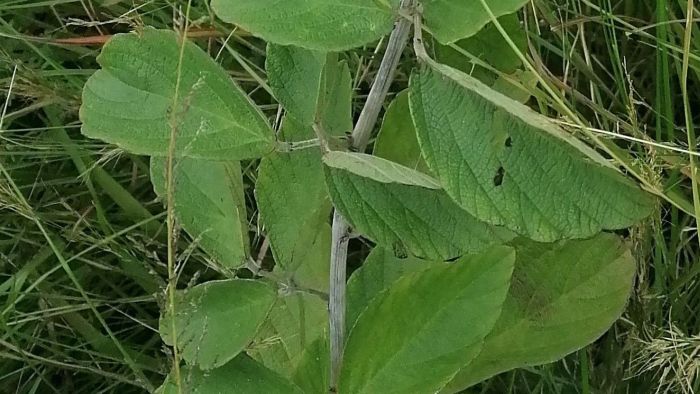Pseudarthria hookeri
Pseudarthria hookeri Wight & Arn.
Family: Fabaceae
Common names: velvet bean, bug-catcher (Eng.); fluweelboontjie (Afr.); uphandosi, uqhonqo, uqwashu (isiZulu)
Introduction
This large shrub has vibrant, eye catching flowers in late summer. It earned the common name ‘bug-catcher’ because it is reputed to catch bedbugs when placed around a sleeping mat.

Description
Description
Pseudarthria hookeri is a robust, upright, deciduous shrub that grows 1–1.5 up to 3 m tall, from a woody rootstock. The stem is angular and velvety. The leaves are trifoliolate, rough, leathery on top, velvety beneath and have protruding veins. The flowers are pink or white, in a crowded, branched inflorescence up to 350 mm long, at the tips of the stems, in late summer to autumn (January to March). Fruit is a straight, velvety, mauve, sticky, hairy pod.

Conservation Status
Status
In the Red List of South African Plants, Pseudarthria hookeri is assessed to be Least Concern (LC), which means no threats are currently posed to this species. Measures have been taken by the Millennium Seed Bank Partnership (MSBP) to ensure long term conservation for this species by collecting the seeds and banking them. Should the status of this plant change, MSBP will play a role in reintroducing the species back to its natural habitat.

Distribution and habitat
Distribution description
Pseudarthria hookeri is widespread in tropical Africa, growing from Senegal to Ethiopia and all the way to South Africa. It grows well in forest margins, on damp hillsides, and in open ground, from the coast to 2 000 m above sea level. In South Africa it is found in the Eastern Cape, KwaZulu-Natal, Limpopo and Mpumalanga Provinces.

Derivation of name and historical aspects
History
The genus name Pseudarthria is derived from pseudo, which means ‘false’, and arthron, meaning ‘joint’, this refers to the constriction between the seeds. This species is named after William Hooker (1785–1865), the first director of the Royal Botanic Gardens at Kew. There are ±6 species in Asia, India and Africa, of which only 1 occurs in South Africa.
Ecology
Ecology
Pseudarthria hookeri is pollinated by bees and other insects. The plant is perennial, but deciduous and completely dies back to the ground in winter. The roots have a symbiotic relationship with certain bacteria in the soil that enables them to fix nitrogen and make it available to plants.

Uses
Use
Pseudarthria hookeri is used to treat pneumonia, cough, abdominal pains and diarrhea. It is also an ingredient in an aphrodisiac. In Zimbabwe the branches are layered around sleeping mats to help catch bed bugs.
It is planted as a soil improver. The leaves are used as green manure.
It is also used ornamentally as a garden plant.
Growing Pseudarthria hookeri
Grow
Pseudarthria hookeri is best grown from seed sown fresh in spring or summer. Seeds have been collected and ready to be germinated in Kwelera National Botanical Garden; this section will be updated shortly.
Grow Pseudarthria hookeri in a sunny position, in well-drained, composted soil, with moderate water in summer and a dry winter. Take care not to overwater. It is well-suited to mixed borders, mixed shrubberies and rockeries and does well in grassland and bushveld gardens. It can be cut back to the ground in winter and will resprout strongly in spring.
References
- Baker, J.G. 1871. Pseudarthria hookeri in Flora of tropical Africa 2: 168.
- Crop Genebank Knowkege Base website. https://cropgenebank.sgrp.cgiar.org/images/file/forage_legumes/breeding%20systems%20table.pdf
- Dzoyem, J.P. et al. 2018. Antibacterial activity and cytotoxicity of flavonoids compounds isolated from Pseudarthria hookeri Wight & Arn. (Fabaceae). South African Journal of Botany 114: 100,103.
- Hyde, M.A. et al. 2021. Flora of Zimbabwe: Species information: Pseudarthria hookeri var. hookeri. https://www.zimbabweflora.co.zw/speciesdata/species.php?species_id=130940. Accessed 14 June 2021.
- Pooley, E. 1998. A field guide to wild flowers Kwazulu-Natal and the eastern region. Natal Flora Publications Trust, Durban.
- Useful Tropical Plants. Pseudarthria hookeri. Wight & Arn. Fabaceae. http://tropical.theferns.info/viewtropical.php?id=Pseudarthria+hookeri. Accessed 26 Apr 2021.
- Wood, J.M. & Evans, M.S. 1902. Natal Plants. Vol. 3, Pl. 219. Accessed via Biodiversity Heritage Library (BHL). https://www.biodiversitylibrary.org/item/57464#page/68/mode/1up
- Foden, W. & Potter, L. 2005. Pseudarthria hookeri Wight & Arn. var. hookeri. National Assessment: Red List of South African Plants version 2020.1. Accessed on 2021/04/26
Credits
Sibahle Gumede
Millennium Seed Bank Partnership
June 2021
Acknowledgments: thanks to Geoff Nichols for images as credited.
Plant Attributes:
Plant Type: Perennial, Shrub
SA Distribution: Eastern Cape, KwaZulu-Natal, Limpopo, Mpumalanga
Soil type: Sandy, Loam
Flowering season: Late Summer, Autumn
PH:
Flower colour: White, Pink
Aspect: Full Sun
Gardening skill: Easy
Special Features:
Horticultural zones








Rate this article
Article well written and informative
Rate this plant
Is this an interesting plant?
Login to add your Comment
Back to topNot registered yet? Click here to register.